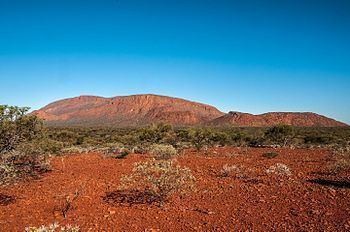Elevation 1,105 m | Area 92 km² | |
 | ||
Similar Mawson Peak, Mount Kosciuszko, Mount Conner, Peña de Bernal, Mount Meharry | ||
Mount Augustus (Burringurrah) is located in the Mount Augustus National Park in Western Australia. The name is also given to the neighbouring pastoral lease, Mount Augustus Station. The local Wadjari people call it Burringurrah, after a Dreamtime figure, a young boy, who was speared and turned into a rock.
Contents
- Map of Mount Augustus East Lyons River WA 6705 Australia
- Monolith monocline distinction
- 1894 gold rush
- Flora and fauna
- Walking tracks
- References
Map of Mount Augustus, East Lyons River WA 6705, Australia
It is a prominent inselberg that stands 1,106 metres (3,629 ft) above sea level, or approximately 860 metres (2,820 ft) above the surrounding plain, and covers an area of 4,795 hectares (18.51 sq mi). It has a central ridge which is almost 8 kilometres (5.0 mi) long.
Monolith - monocline distinction
Mount Augustus is widely claimed in tourist promotional and information literature as the "world's largest monolith", but the claim does not originate from the geological literature, nor is substantiated by any other scholarly research.
Mt. Augustus is more than twice the size of Uluru. Unlike Uluru, which is a monolith and, in general, devoid of plant growth, Mt. Augustus is a monocline (an asymmetrical anticline).
According to the Geological Survey of Western Australia, Mount Augustus is an asymmetrical anticline (rock layers that have been folded into an arch-like structure) which is steeper on its north-eastern side than the south-west.
The rocks consist of sand and gravel that were deposited by an ancient, south-easterly flowing river system that drained the region about 1,600 million years ago. This river system flowed over a faulted and eroded surface of 1,800–1,620 million- -year-old granitic and metamorphic rocks. The river deposits consolidated to form sandstone and conglomerate, and were then buried beneath younger marine sediments, which were laid down when shallow seas covered the region between 1,600–1,070 million years ago. The rocks were buckled into their present-day structure about 900 million years ago when movement along faults in the underlying granitic and metamorphic rocks caused localised, strong, north-east directed compression. The marine sedimentary rocks that overlay the sandstone and conglomerate have since been eroded from Mount Augustus, but now form the hills around Cobra and Mount Augustus homesteads. Erosion has also removed sandstone and conglomerate from the north-western end of Mount Augustus to expose the underlying granitic rocks at The Pound.
1894 gold rush
There was a gold rush in the 1890s due to local geology.
Flora and fauna
Wattles, cassias and eremophilas dominate the plant life and the animal life include emus, red kangaroos, goannas, euros and birds of prey. There is over 100 species of birds on and around Mount Augustus.
Walking tracks
The climb to the summit can take up to 5 hours (return) and there are two trails (one class 4 and the other a class 5) to get there. There are a number of walking tracks to explore.
